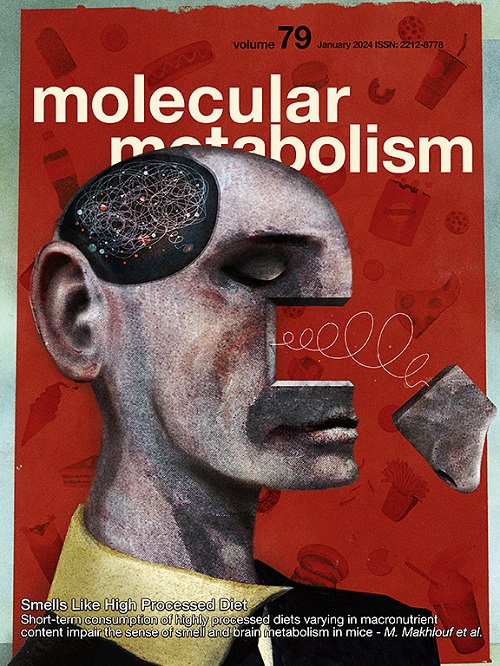Reduced liver mitochondrial energy metabolism impairs food intake regulation following gastric preloads and fasting
IF 6.6
2区 医学
Q1 ENDOCRINOLOGY & METABOLISM
引用次数: 0
Abstract
Objective
The capacity of the liver to serve as a peripheral sensor in the regulation of food intake has been debated for over half a century. The anatomical position and physiological roles of the liver suggest it is a prime candidate to serve as an interoceptive sensor of peripheral tissue and systemic energy state. Importantly, maintenance of liver ATP levels and within-meal food intake inhibition is impaired in human subjects with obesity and obese pre-clinical models. Previously, we have shown decreased hepatic mitochondrial energy metabolism (i.e., oxidative metabolism & ADP-dependent respiration) in male liver-specific, heterozygous PGC1a mice results in increased short-term diet-induced weight gain with increased within meal food intake. Herein, we tested the hypothesis that decreased liver mitochondrial energy metabolism impairs meal termination following nutrient oral pre-loads.
Methods
Liver mitochondrial respiratory response to changes in ΔGATP and adenine nucleotide concentration following fasting were examined in male liver-specific, heterozygous PGC1a mice. Further, food intake and feeding behavior during basal conditions, following nutrient oral pre-loads, and following fasting were investigated.
Results
We observed male liver-specific, heterozygous PGC1a mice have reduced mitochondrial response to changes in ΔGATP and tissue ATP following fasting. These impairments in liver energy state are associated with larger and longer meals during chow feeding, impaired dose-dependent food intake inhibition in response to mixed and individual nutrient oral pre-loads, and greater acute fasting-induced food intake.
Conclusions
These data support previous work proposing liver-mediated food intake regulation through modulation of peripheral satiation signals.
胃预负荷和禁食后肝脏线粒体能量代谢减少损害食物摄入调节。
目的:肝脏作为外周传感器调节食物摄入的能力已经争论了半个多世纪。肝脏的解剖位置和生理作用表明,它是作为外周组织和全身能量状态的内感受传感器的主要候选者。重要的是,在肥胖和肥胖临床前模型的人类受试者中,肝脏ATP水平的维持和餐内食物摄入抑制受到损害。之前,我们已经证明,雄性肝脏特异性杂合PGC1a小鼠肝脏线粒体能量代谢(即氧化代谢和adp依赖性呼吸)的降低会导致饮食诱导的短期体重增加,同时增加餐内食物摄入量。在此,我们验证了肝脏线粒体能量代谢减少的假设,即在营养物质口服预负荷后损害进食终止。方法:检测肝脏特异性杂合子PGC1a雄性小鼠空腹后肝脏线粒体呼吸对ΔGATP和腺嘌呤核苷酸浓度变化的反应。此外,研究了基础条件下、营养预负荷后和禁食后的食物摄取量和摄食行为。结果:我们观察到雄性肝脏特异性,杂合PGC1a小鼠在禁食后对ΔGATP和组织ATP变化的线粒体反应降低。这些肝脏能量状态的损害与以下因素有关:进食时进食时间更长、进食时间更长、对混合和单个营养口服预负荷的剂量依赖性食物摄入抑制受损,以及急性禁食引起的食物摄入增加。结论:这些数据支持了先前提出的肝脏通过调节外周饱足信号介导食物摄入调节的研究。
本文章由计算机程序翻译,如有差异,请以英文原文为准。
求助全文
约1分钟内获得全文
求助全文
来源期刊

Molecular Metabolism
ENDOCRINOLOGY & METABOLISM-
CiteScore
14.50
自引率
2.50%
发文量
219
审稿时长
43 days
期刊介绍:
Molecular Metabolism is a leading journal dedicated to sharing groundbreaking discoveries in the field of energy homeostasis and the underlying factors of metabolic disorders. These disorders include obesity, diabetes, cardiovascular disease, and cancer. Our journal focuses on publishing research driven by hypotheses and conducted to the highest standards, aiming to provide a mechanistic understanding of energy homeostasis-related behavior, physiology, and dysfunction.
We promote interdisciplinary science, covering a broad range of approaches from molecules to humans throughout the lifespan. Our goal is to contribute to transformative research in metabolism, which has the potential to revolutionize the field. By enabling progress in the prognosis, prevention, and ultimately the cure of metabolic disorders and their long-term complications, our journal seeks to better the future of health and well-being.
 求助内容:
求助内容: 应助结果提醒方式:
应助结果提醒方式:


